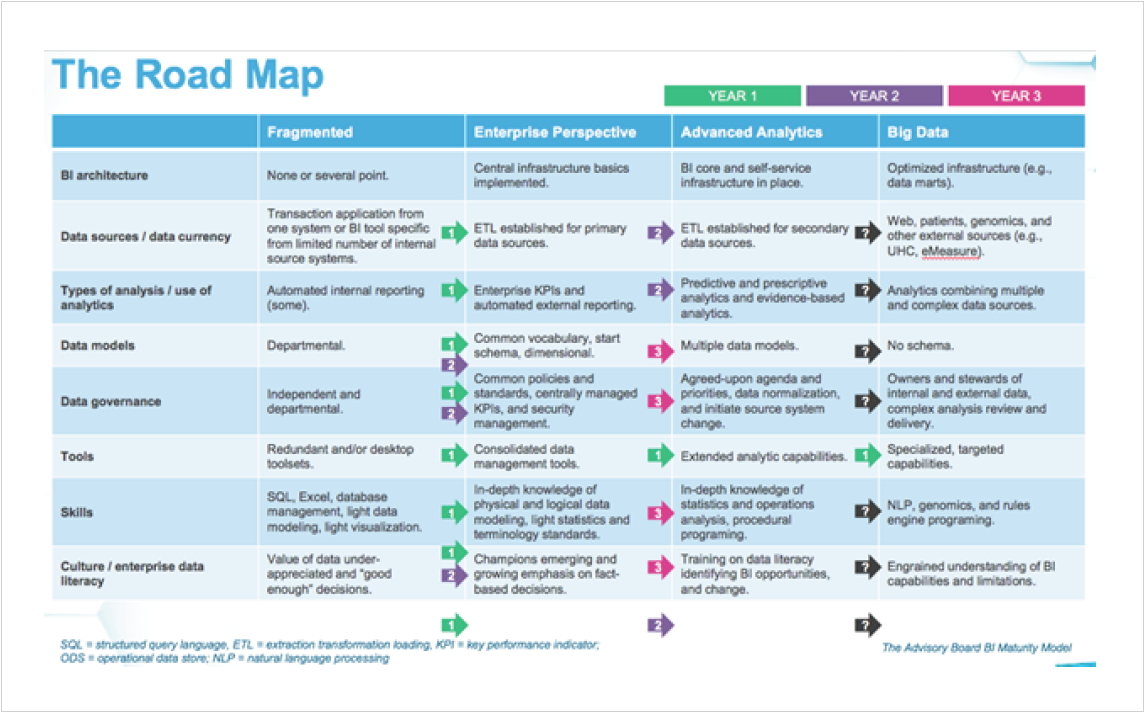Read how The University of Kansas Health System embraced the implementation of an advanced analytics team to help the healthcare system unleash the data capabilities needed to become a data-driven organization.
The ability to effectively use data for strategic decision making is imperative for healthcare organizations in this era of increasing at-risk payment models and stiff competition. Yet, healthcare still lags behind most other sectors when it comes to the acquisition, storage, and analysis of data.
The University of Kansas Health System is a large academic medical system with more than 80 locations operating in two states, 999 licensed beds, and over 700 employed physicians. Recognizing the need to more effectively utilize data and analytics to help answer important strategic questions, the health system commissioned an advanced analytics team to help unleash the data capabilities needed to have a competitive edge.
The ability to quickly bring together timely, accurate, and comprehensive data for strategic decision making is an imperative for healthcare organizations, especially in the era of increasing at-risk payment models, reduced reimbursements, extensive consumer demand, and evolving healthcare technologies. However, despite the importance of data in improving operational efficiency, healthcare ranks as one of the least digital industries, ranking lower than all industries except construction, agriculture and hunting, and the hospitality industry.1
Healthcare organizations that seek to set themselves apart recognize that data is an asset, and analyzing data is a supporting function of any good competitive strategy. Performance improvements arise from analytics models that allow managers to predict and optimize outcomes. As more companies learn the core skills of using big data, building superior capabilities will become a critical competitive asset.2 A well-developed analytics strategy, supported by a high performing advanced analytics team, can enable a data-driven culture that drives business transformation.3
A data-centric approach to healthcare requires visionary leaders who are passionate advocates of data, willing to build their strategies around extensive analysis and fact-based decisions.4 The University of Kansas Health System, a large academic medical system with more than 80 locations operating in two states, 999 licensed beds, over 700 physicians and 10,000 employees, has a vision of leading the nation in caring, healing, teaching, and discovering. To better accomplish its ongoing mission, The University of Kansas Health System needed to make more effective use of its data.
The University of Kansas Health System’s journey from fragmented, non-integrated, and disparate data sources—to the implementation of an advanced analytics team supporting decision making and strategy—was a multi-year journey that began with recognizing the need for an integrated approach to data as the organization struggled to extract meaningful analytics from its data.
Among the health system’s leadership, agreement existed that data was an asset and that analyzing data was a supporting function of strategy. However, decisions were based on limited data, or sometimes on hunches or gut instinct. Without advanced analytics to support strategic decision making, there was no way to know if the organization was making the best possible decision.
To ensure a coordinated approach to leveraging data, the healthcare system had established a data governance structure with a centralized team responsible for developing advanced analytics. A hybrid model of centralized and decentralized data governance was also used, as it worked well within The University of Kansas Health System’s organizational culture.
The University of Kansas Health System had previously implemented a Healthcare Analytics Warehouse and Knowledgebase (HAWK), an integrated enterprise data warehouse using the Health Catalyst® Analytics Platform and the organization’s operational analytics capabilities that included a broad suite of analytics applications, as its infrastructure and primary source for data and analytics. The enterprise data warehouse enables the organization to automate extraction, aggregation, and integration of clinical, financial, administrative, patient experience, and other relevant data. Further, it allows the health system to apply advanced analytics to organize and measure clinical, patient safety, cost, and patient outcomes.
Leadership at The University of Kansas Health System implemented a three-year phased road map, outlining its move from a fragmented and immature business intelligence (BI) system to an organization that makes effective use of its data via a data warehouse, data marts, and analytics. The plan addressed all the aspects of managing and integrating data to create a data-driven organization, from BI architecture, data models, data governance, tools and skills, to culture and enterprise data literacy (see Figure 1).

Analytics capabilities were phased in over time. Developing the talent skillset and bandwidth had to build slowly as the organization transitioned through each layer. Leadership knew that technology alone was not enough to drive insights—it needed infrastructure and people with the right skills.
Once the foundational capabilities were in place, the demand for advanced analytics intensified. Understanding the competitive advantage of advanced analytics, leadership at The University of Kansas Health System believed the organization was poised to jump on the opportunity to go to the next step.
Leadership made the pitch to the CEO for the need to implement an advanced analytics team that could develop information from data and efficiently translate that data into actionable knowledge better and faster than the competition.
The University of Kansas Health System CEO challenged the leadership team to carry out a two-month pilot, effectively asking for proof that an advanced analytics team could quickly answer key strategic and business questions. To support their efforts, the CEO gave the team the go-ahead to assemble a team of people and identify key resources without creating a new cost center or reporting structure.
The leadership team knew that the success of the pilot would depend on being able to prove that a dedicated advanced analytics team would bring genuine value to the healthcare system. Executives provided the leadership team with an extensive list of issues and questions that were important and in need of answering. To determine which questions would be addressed first, the questions were evaluated and placed on a matrix that weighed impact, level of effort, team expertise, and level of engagement of subject matter experts and key stakeholders.
The outcome of the analysis produced a prioritized list of 23 questions to answer, sequenced in five phases (see Figure 2).

Specific skills and expertise would be needed to effectively tell the story about the challenges and opportunities that The University of Kansas Health System faced, and the potential ways of addressing them using data and advanced analytics. A list of roles, expertise, and people that could help drive success was developed. This list included data experts—those that knew exactly where to find the data— analysts, and statisticians, as well as others with experience and expertise from across the organization, from finance and business strategy to IT.
Those experts in analysis, data knowledge, and economic impact were inspired by and committed to the vision of a data-driven, strategic culture enabled by advanced analytics and were excited to participate in the pilot. The team embraced the challenge, and jumped into the work with enthusiasm, working together to create data models, including predictive models, visualizations, and producing insightful summaries that turned previously inaccessible, invisible data into visible and actionable information.
In two short months, the team demonstrated its value through a successful pilot. Answering important strategic questions led to the applied analytics team becoming a permanent part of the new performance improvement department.
The implementation of an advanced analytics team has enabled The University of Kansas Health System to unleash its data, to probe and answer previously elusive key questions, resulting in clinical, operational, and financial insights, and actionable knowledge that can be applied to address high-priority strategic problems, including:
“We pride ourselves on using data and analytics to make decisions, and drive our work on things we can measure, but know that we can always do better. From a clinical and process perspective, our goal is always to compress the time-value curve, and to improve our data quotient.”
– David Wild, MD, Vice President, Performance Improvement
The University of Kansas Health System will continue to transform its organizational strategic decision-making ability by expanding the use of targeted analytics, and moving those analytics closer to real time, closing the time to value gap, using analytics as a competitive advantage.




